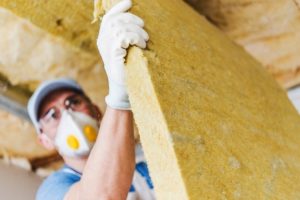Insulation comes in several types and is used to slow the heat transfer through walls, attics, ducts or roofs. Your goal for your home should be to lose less warm air in the winter months and less cool air in the summer months. This will in turn reduce your heating and cooling needs.
Types of insulation that can be used for attics are spray foam, loose-fill, fiberglass, cellulose, and fiberglass batts.
- Loose fill insulation comes in bags and is blown in place.
- Fiberglass comes from recycled glass sand that has been melted and spun into fibers.
- Cellulose is made from recycled post-consumer paper treated for resistance to insects and fire.
- Fiberglass batts comes in packaged rolls.
Types of insulation that can be used in walls are rockwool batts and blankets, cotton batts which are denim material, concrete blocks, foam board, loose-fill fiberglass, and sprayed foam. Sprayed foam is one of the most popular options, is very cost effective and you can do it yourself. While insulating interior walls is not common it does offer energy savings and can dampen sound.
While some may not think to insulate floors this is an important area to not forget. Homeowners can save money on heating and cooling costs by insulating spaces under floors. Foam or fiberglass is what needs to be used to insulate floors. Rigid foam board should be used between floor joists in crawl spaces.
When considering ceiling insulation keep in mind that batts or blanket insulation is the best choice for flat ceilings. These batts or blankets include polyester, natural wool, glass wool, and rockwool.
Whenever you are working with fiberglass insulation you need to be protected with long sleeved shirts and pants. You should also have sturdy socks and enclosed shoes. Hats are also a good idea. An even better idea is to wear disposable coveralls. Wear gloves on your hands. You do not want fiberglass particles on your skin.
You should certainly wear goggles and a dust mask to keep you safe when working with insulation. Inhaling fibers from fiberglass can become lodged in your lungs and cause difficulty in breathing.
When insulating your home with spray insulation, you can rent the necessary equipment. There are also insulation contractors that can do the job for you.
The EPA estimates that homeowners will save an average of 15% on heating and cooling costs by sealing their homes and adding insulation in attics, floors over crawl spaces, and accessible basement rim joists.


